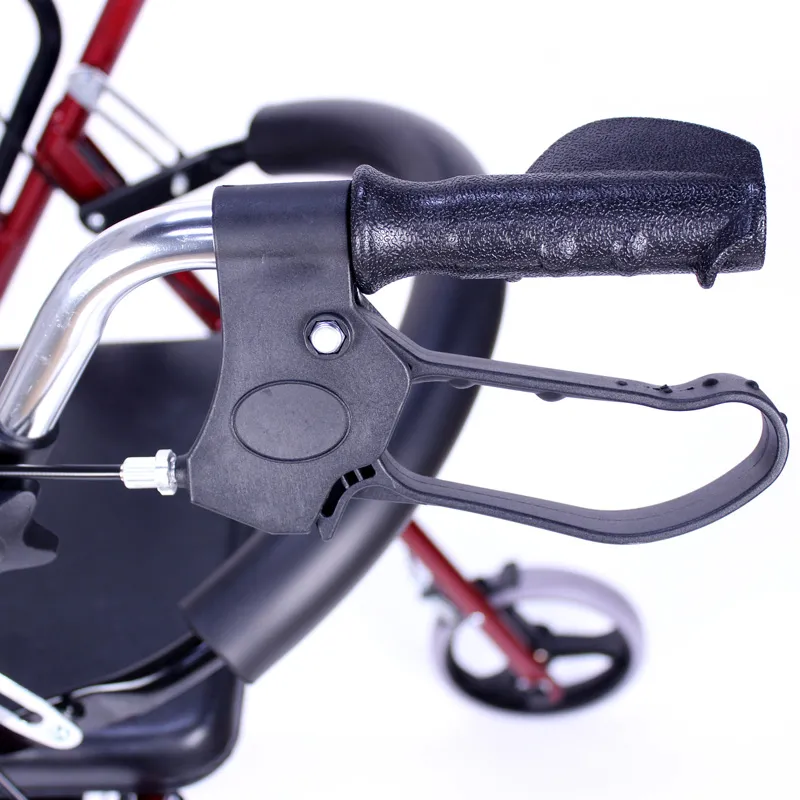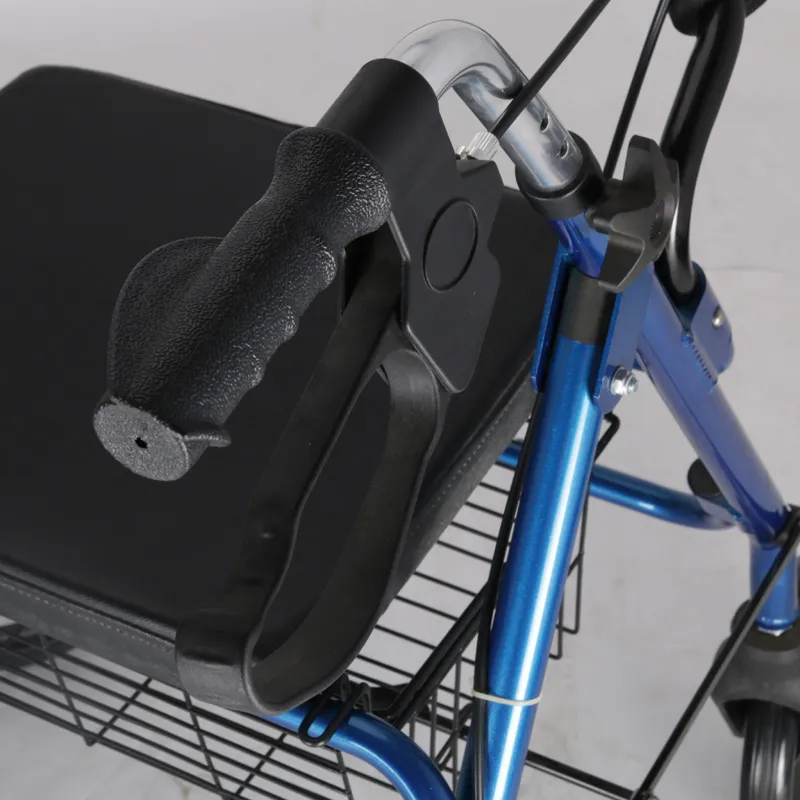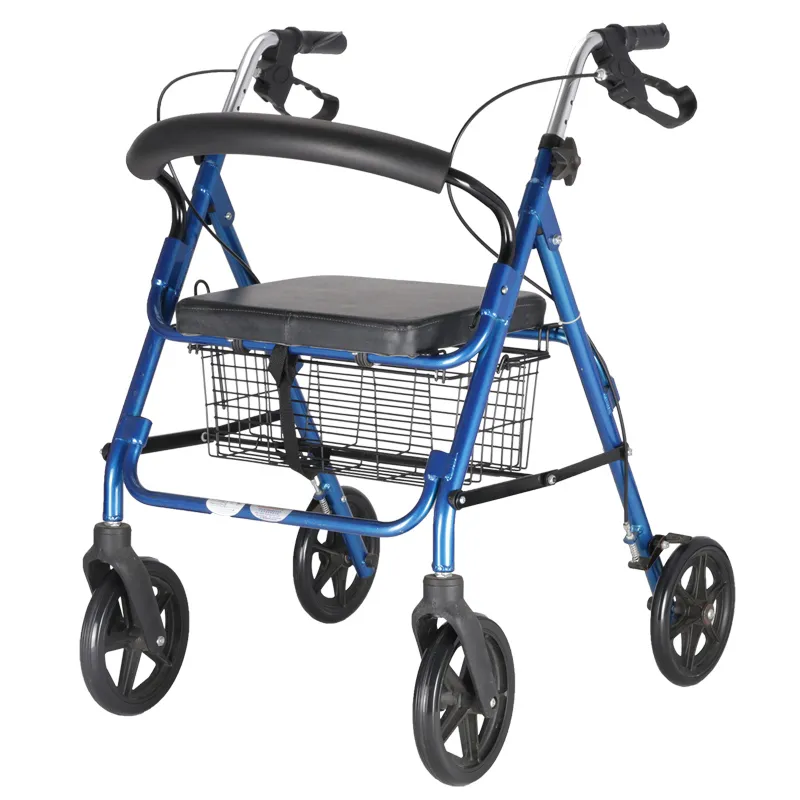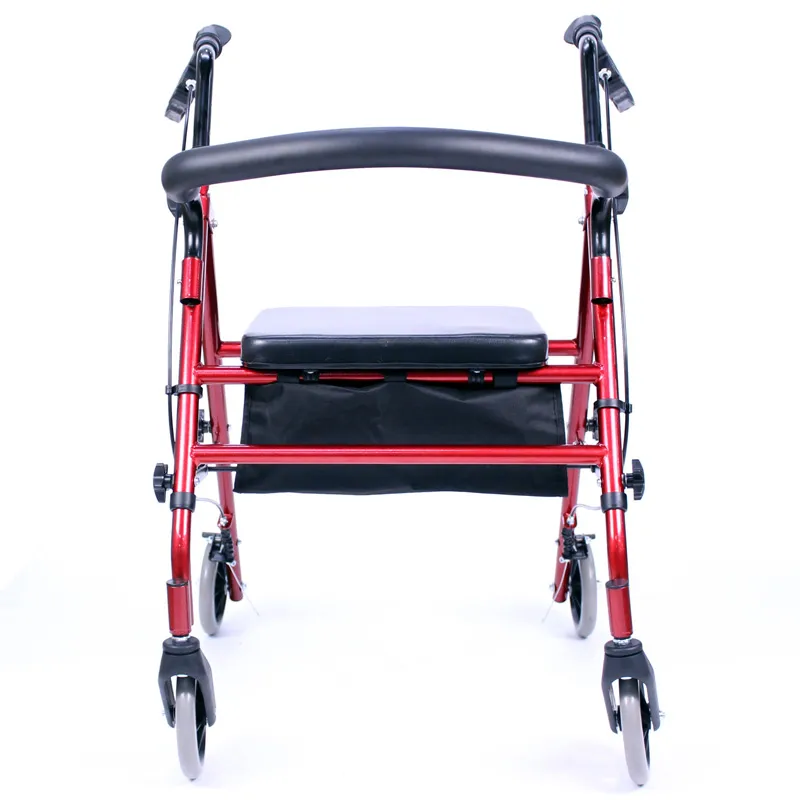The four wheel rollator walker is a common mobility assistance device that is widely used by the elderly, those recovering from surgery, or those with reduced mobility. It helps users maintain balance, reduces the risk of falls, improves walking stability, and provides resting support during long walks.
However, using a four wheel rollator walker is not suitable for everyone. Physical condition, balance ability, upper body strength and cognitive level vary greatly among different groups of people. Blindly using a rollator may not only fail to achieve the assistive effect, but may increase the risk of falling or injury.
This article will provide an in-depth analysis of who is not suitable for using the four wheel rollator walker from the perspective of professional rehabilitation medicine and geriatric care, as well as the specific reasons, to help readers correctly understand the applicable boundaries of the rollator.

What is a four wheel rollator walker?
The four wheel rollator walker is a walking aid with four wheels, a handbrake system, a seat cushion and a storage basket. Compared with traditional wheelless or two-wheeled walkers, the four-wheel rollator walker is more flexible and easier to move, and is suitable for people with a certain balance and strength.
Key features include:
• Four universal wheels for easy steering and smooth walking
• The handle has a braking system to control speed or stop
• There is usually a cushion in the middle for temporary rest
• Suitable for outdoor use, can pass through flat ground
But these advantages also mean that users must have a certain amount of upper limb control and balance. Therefore, it is not safe for all persons with reduced mobility.

Why isn’t a rollator suitable for everyone?
Rollators are designed to assist walking, not to provide full support.
Users need to maintain posture and gait control on their own on the basis of a rollator. If the physical or cognitive functions are not up to par, the problem of “using the wrong device for the wrong person” arises.
For example:
• If a person is unable to hold the handle firmly or is slow to react, a fall may result when braking;
• If the gait is unstable and the body is severely tilted, the four wheel rollator walker may be "unsteady" or even slide too fast;
• If the visual or cognitive impairment is severe, the user cannot judge the ground environment and may be in danger.
Next, we will analyze in detail who should not use the four wheel rollator walker and explain why.
Can someone with extremely poor balance or complete loss of balance control use a rollator?
The answer is: no.
The four wheel rollator walker mainly plays the role of "assisting balance", rather than a tool that "fully supports" the body's weight.
If a person is completely unable to stand or maintain an upright position without support, using a rollator will not only help but may lead to instability, rollover or fall.
Here’s why:
• Rollators are sliding and do not provide stable support like wheelless walkers;
• When the body's center of gravity relies entirely on the rollator, the wheels are prone to slipping due to changes in ground resistance;
• Once the user cannot brake or re-adjust the posture in time, it will lead to a fall.
This population should generally consider a wheelless or two-wheeled walker, or a higher-support device such as a gait trainer, lift frame, or wheelchair.

Is the four wheel rollator walker suitable for people with insufficient upper limb strength or weak joints?
Also not suitable.
Although the rollator has wheels, the user needs to have sufficient upper body strength and flexibility to control speed, braking and direction.
Especially the brake handle of the four wheel rollator walker must be able to hold firmly, squeeze and maintain control. If the user's hand strength is insufficient, the following risks may occur:
• Failure to brake in time causes the rollator to slide;
• Loss of balance due to loose handle;
• Upper limbs fatigue too quickly, affecting walking safety.
Typical unwell people include:
• Those with arthritis or severe degeneration of the wrist joint;
• Those who have insufficient upper limb muscle strength after stroke;
• Patients with neurogenic myasthenia or advanced Parkinson's disease.
This group of people can use a light walking frame or wheelchair instead under the guidance of a rehabilitation practitioner.
Why shouldn’t people with cognitive disabilities or slow reflexes use a rollator?
The operation of the four wheel rollator walker requires active control and environmental judgment capabilities.
If the user has cognitive impairment (such as dementia, Alzheimer's disease) or slow reaction, they often cannot operate the brakes correctly, adjust the direction, or even perceive the surrounding risks.
The main risks are as follows:
• Forgetting to brake, causing the rollator to slide;
• Unable to recognize downhill slopes or steps, making it easy for people and vehicles to fall;
• Inability to sit or stand up correctly, resulting in imbalance;
• Improper operation, such as using the brakes incorrectly or pushing the vehicle in the opposite direction.
During the rehabilitation or care stage, it is usually recommended that these users use fixed walkers or be assisted by caregivers in moving.
Can people with severe lower limb deformity, muscle atrophy or complete dependence on support for movement use it?
The four wheel rollator walker is not recommended.
Rollators are designed for people with "some remaining ability to walk."
If the muscles of the lower limbs are severely atrophied, the joints are deformed, or the person relies on external force to walk, the rollator cannot provide an adequate support surface.
Potential risks include:
• The user’s weight rests on the rollator causing the structure to tilt;
• The shift in the center of gravity causes the rollator to tilt forward or slide;
• Shoulder and wrist injuries caused by prolonged hanging support.
For this type of patients, priority should be given to electric wheelchairs, gait training vehicles, or standing support equipment, and individualized assessment by a rehabilitation therapist.

Can people with visual impairments or poor spatial perception use a rollator?
Not recommended.
The four wheel rollator walker requires high environmental awareness.
Users need to constantly observe ground conditions, obstacles ahead, steps and ramps. If you have poor vision or poor spatial judgment, a rollator can become a "sliding hazard."
Common risks include:
• Unable to see the height difference on the ground, resulting in falls;
• Collision with walls, furniture or curbs while pushing;
• Misjudgment of distance and loss of balance.
Therefore, people with visual impairment or spatial disorientation should not use a rollator alone.
They should choose more stable assistive devices with the assistance of a caregiver or guide.
Is it suitable for people with severe heart or lung disease or who get tired easily?
These people need to use rollators with caution.
Although a rollator can provide a resting cushion, continuous walking and pushing the equipment still require a certain amount of physical strength. If your cardiopulmonary function is poor, prolonged exercise may cause difficulty breathing, dizziness or even syncope.
Reasons for risk include:
• Although the four wheel rollator walker is lightweight, it requires continuous upper body thrust;
• When walking uphill or on uneven roads, higher cardiopulmonary endurance requirements are required;
• Once sudden symptoms (such as chest tightness or dizziness) occur, it is difficult to brake in time or rest on the spot.
Such people should evaluate their exercise tolerance under the guidance of doctors and rehabilitation therapists and choose lighter indoor walkers or wheelchairs.
Are overweight people not suitable for using the four wheel rollator walker?
Not suitable for some overweight people.
Most rollators have a specific maximum weight limit (usually 100–135kg).
If the user's weight exceeds this range, the frame and axle of the rollator may not be able to withstand long-term pressure, which may easily cause safety hazards such as structural deformation, brake failure, or axle breakage.
Therefore, before purchasing a rollator, you should carefully check the product's load-bearing instructions and have a professional confirm whether it meets the user's weight and height ratio.
Can people with complex ground conditions or narrow home spaces use rollators?
The four wheel rollator walker has certain requirements on the environment.
If the use environment is too narrow, the ground is uneven, or there are obstacles, it may increase the risk of falling.
For example:
• The thresholds in the home are too high and the corridors are too narrow;
• Floors are slippery or have thick carpets;
• Going up and down stairs requires frequent folding of the rollator.
These conditions will affect the safety and operational flexibility of the rollator.
For those who live in small spaces or have steps, it is recommended to choose a wheelless walker or a foldable lightweight cane-style support device.
What are the prerequisites for using a rollator?
In rehabilitation medicine, the following basic conditions need to be met when using a rollator:
• Lower limb muscle strength: able to independently support at least 60% of body weight;
• Upper body strength: Able to hold the handle firmly and operate the brake;
• Balance ability: Ability to stand still for about 10 seconds without support;
• Cognition and Vision: Ability to understand operating procedures and identify environmental risks
• Safety awareness: Know how to brake, how to get up and sit down properly on the seat.
If the above conditions are not met, a more appropriate walking assistance method should be selected after evaluation by a doctor or rehabilitation therapist.

How to correctly assess whether you are suitable for using a rollator?
The most scientific way is to conduct professional rehabilitation assessment.
Assessment content includes:
• Gait analysis: observe stride symmetry, stride length and pace;
• Balance test: Use Berg balance scale or Tinetti test;
• Muscle strength assessment: Measure upper and lower limb muscle strength;
• Cognitive assessment: Confirm understanding and safety awareness;
• Environmental Assessment: Examine home floor conditions and living spaces.
Based on the assessment results, the rehabilitation therapist will recommend the most appropriate type of rollator or suggest switching to other assistive devices.
Walkers are not a universal auxiliary tool
The four wheel rollator walker can indeed significantly improve the quality of life for the right people, but incorrect use may increase risks.
A four wheel rollator walker should not be used by persons without balance, strength, cognition or vision.
The correct approach is to have it evaluated by a professional rehabilitation practitioner and choose a walking aid that matches your physical condition.
Only by paying equal attention to safety and adaptability can rollators truly become a guarantee of freedom of movement rather than an invisible source of danger.
What products does Dayang Medical supply?
Our company in China is a specialized manufacturer and supplier of a wide range of medical devices. We produce electric wheelchairs, manual wheelchairs, sports wheelchairs, patient beds, commodes, walkers, rollators, shower chairs, and walking sticks. Many brands cooperate with our factory because we offer OEM customized production, wholesale sales, and flexible discount promotions.
Hospitals, rehabilitation centers, and mobility distributors choose to purchase from us due to our high quality, low prices, reliable supply chain, and professional service.


